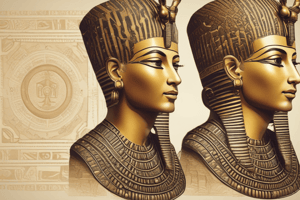Podcast
Questions and Answers
Who was the last ruler of the powerful pharaoh dynasty?
Who was the last ruler of the powerful pharaoh dynasty?
- Ray Johnson
- Tutankhamun (correct)
- Amenhotep IV Akhenaten
- Amenhotep III
What significant event regarding Tutankhamun occurred in 1922?
What significant event regarding Tutankhamun occurred in 1922?
- His CT-scan
- His ascension to the throne
- His mummification
- Discovery of his tomb (correct)
Which pharaoh ruled for only four years before Tutankhamun?
Which pharaoh ruled for only four years before Tutankhamun?
- Hatshepsut
- Amenhotep III
- Ramses II
- Amenhotep IV Akhenaten (correct)
What notable worship practice was associated with Akhenaten?
What notable worship practice was associated with Akhenaten?
What issue occurred during the CT-scan of Tutankhamun on January 5, 2005?
What issue occurred during the CT-scan of Tutankhamun on January 5, 2005?
Flashcards are hidden until you start studying
Study Notes
Tutankhamun's Legacy
- Last ruler from a significant pharaoh dynasty, known for his young age and sudden death.
- Howard Carter discovered Tutankhamun's tomb in 1922, sparking global interest in ancient Egypt.
Historical Context
- Amenhotep III reigned for approximately four decades before Tutankhamun.
- Amenhotep IV, also known as Akhenaten, was his son, famous for introducing worship of Aten, the sun disk.
- Akhenaten moved the capital from Thebes to Amarna and was known for attacking the traditional worship of Amun.
Mysteries and Succession
- The period surrounding Akhenaten’s reign was marked by unconventional and mysterious rules, leading to uncertainties about his successors.
- Tutankhamun ascended to the throne after Akhenaten but reversed the policies favoring Aten, restoring traditional worship of Amun.
Advances in Research
- Ray Johnson, director of the University of Chicago's research center, led a CT scan study of Tutankhamun's remains.
- A CT scanning machine was employed for the study on January 5, 2005, revealing insights into the pharaoh's health and death.
- The scanning process faced interruptions due to sand, reflecting the challenges of studying ancient artifacts.
Cultural Significance
- The physical remains of Tutankhamun and the artifacts found in his tomb continue to provide valuable information about ancient Egyptian culture and burial practices.
- The pallbearers, depicted in ancient texts as carrying the coffin, symbolize the elaborate funerary rites of pharaohs.
Studying That Suits You
Use AI to generate personalized quizzes and flashcards to suit your learning preferences.




